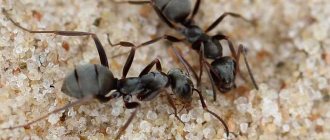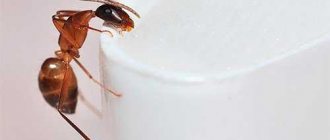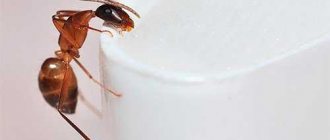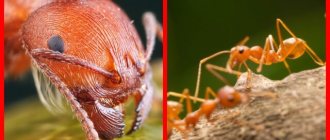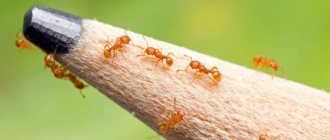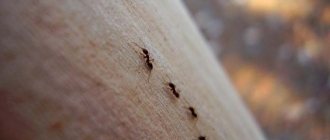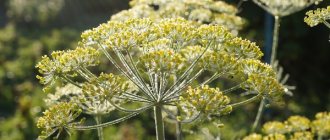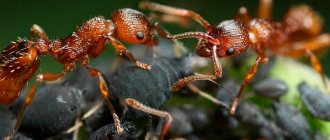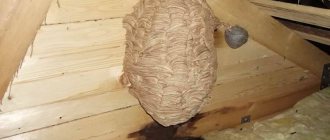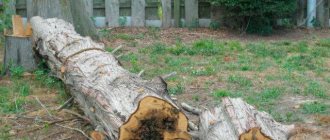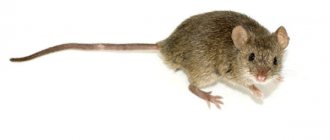11/02/2018 Category: AntsAuthor: Katerina Starikova
Often in the forest you can see large anthills in which insects are swarming. Often these are forest (red) red ants. Although they live in forests, they can also settle on your site.
- 2 Harm and benefits from insects
- 3 Methods of dealing with red ants
3.1 Ways to get rid of insects in the house
- 3.2 Elimination of ants on the site and in the greenhouse
- 5.1 Reviews
Who are ants?
Ants are a family of insects and a superfamily of Ants. It should be noted that these are the most numerous representatives of the entire family. Why are these creatures so interesting? Despite their small size, they have a rather complex organization of their society. There is even a whole science that studies ants and their behavior, called myrmecology.
It is difficult to describe all the diversity of these insects, and therefore we will only talk about forest ants, which we often encounter. In the middle part of Eurasia, as a rule, three varieties can be found. I would like to talk about them in more detail.
Harm
Despite a lot of positive aspects, such a neighborhood can cause a lot of problems. After all, the most important indicator here is the number of such living creatures. If there is too much of it, the positive aspects are no longer so noticeable. After all, the vegetation begins to feel much worse. So, what is the harm from ants in the garden ?
Firstly, the abundance of insects on the ridges changes the properties of the soil. It becomes more sour. In addition, these individuals are not particularly selective when it comes to home improvement. They triple their anthills wherever they have to. It could also be a garden bed. Living next to a house infested with animals can be deadly for many cultures.
In addition, such a “trifle” does not disdain various sweet fruits. And in a matter of days he can gnaw a strawberry, or, say, a pumpkin. Carrots also serve as a good treat for them. There are also varieties that prefer flowers. The appearance of your flower beds can be greatly affected.
As noted earlier, living creatures spread seeds. But they're not always useful. Weeds spread the same way. Don't underestimate them. Insects can destroy not only petals, but also entire trees, because they eat in quantity. But most of all, gardeners fear these “hard workers” as carriers of aphids.
The fact is that this green bug is like a vessel with sweet nectar for them. Small creatures carry this liquid on their bellies, diluting it with their secretions. That’s why ants carry harmful living creatures with them everywhere. In addition, they protect her from danger. As a result, aphids reproduce at a breakneck speed and eat foliage and other parts of vegetation.
Red myrmica
Myrmica is a species of small red ants, about four to five centimeters long. The body has a color from yellow to red and brown. This species is most common in Eurasia. Such forest ants are often found in meadows and vegetable gardens, competing with the well-known black ones. An interesting fact is that they have mastered not only wild nature, but also urban landscapes. To protect themselves, small red ants use a sting and poison, which has a rather painful effect on the body, especially when the bites are numerous. Sometimes people have an allergic reaction due to the ingress of acid (formic).
Ants in the garden
Gardens and vegetable gardens are also ecosystems, but created by human hands. Ants also live in them - red forest, black or brown. They perform the same functions here as in the forest or meadow. On the one hand, their activities bring benefits to people, but, unfortunately, not only that.
Benefit
If we talk about what benefits ants bring to people, then this is actually what they do in the wild:
- They regulate the chemical composition of the soil, which increases its fertility. Thus, thanks to the activity of these insects, the amount of phosphorus in the soil increases 10 times, and potassium - 2 times.
- Penetrating deep into the soil, they distribute and mix the applied fertilizers and nutrients.
- Destroy pests, including slugs, caterpillars, beetles, flies, etc. This allows you to avoid using chemicals to get rid of pests.
- They pollinate flowers.
Damage caused by ant families
Unfortunately, ants are not only beneficial, but also harmful insects. They:
- The roots are spoiled. Most often, young seedlings suffer from them - their roots and shoots are still tender, and insects feast on them with pleasure.
- They spoil the trees. If there are carpenter ants in the garden, the plants are in danger. Moreover, if there are wooden buildings on the site, the ants will get to them.
- Increases the acidity of the earth.
- They eat sweet fruits.
- They eat the sown seeds.
- They spread weed seeds.
But the most important thing about how ants are dangerous is their “pets”. We are talking about aphids. Ants do not eat aphids, but feed on their sweet secretions. The aphid itself feeds on plant sap. The more aphids, the more sap it will draw from the plant, thereby weakening it.
Attention! If no measures are taken, aphids can cause the death of more than one plant, since the ants move their “pets” to neighboring plants to provide them with good nutrition and conditions for reproduction.
Does it make sense to have ants?
Not every garden or plot has ants. The owners, having read about the benefits of their presence, decide to make up for this deficiency and are looking for ways to resolve the issue. This can be done in several ways:
- Having bought a family with a uterus in a specialized store. This option is quite complex and requires studying specialized literature and time.
- Brought from the forest or field. To do this, you can dig up part of the anthill in another place and move it to a prepared site. The disadvantage is that with all the actions to move the ant family, the queen and some of the ants may die, and the rest will leave in search of a safer place.
- Wait until the ants come on their own. This option takes the longest time, but is also the most reliable.
Important ! Before getting ants, you need to consider whether the benefits of these insects will outweigh the harm they cause.
Family with a uterus
Myrmiki lifestyle
However, the insects themselves are capable of an aggressive attack only if their anthill in the forest is damaged. Myrmikas build nests on the ground, under pebbles and in tree stumps and moss hummocks. Their families number from 10 to 12 thousand individuals. At the same time, there can be up to one hundred egg-laying females. Members of one family live in several nests, which are connected to each other not only by ground paths, but also by underground passages. Some of these “houses” are permanent, they are inhabited all year round. Other buildings are seasonal; insects use them only in the summer. Before wintering, all members of the huge family move to large permanent nests.
Small ants use their summer quarters to raise numerous larvae, pupae and root aphids.
Myrmics hunt small invertebrates, eat flower nectar, and grow colonies of aphids on plant roots. Scout ants search for food. Having found food, they leave scent trails, then return to the anthill for help and correctly lead out their fellows according to their own marks.
The best chemicals
Manufacturers produce a wide range of professional insect control products that can be used without fear for the health and safety of people and animals. They effectively destroy ants in a short time.
"Ant-eater"
The cheap product comes in powder and clear liquid form. Used to control insects in the form of a solution. To obtain the required concentration, dilute 1 ml of liquid or 1 gram in 10 liters of water. powder. This amount of solution is designed to treat 5 square meters of area.
Advantages:
- the drug does not accumulate in the soil;
- Does not harm worms, pets or birds.
Disadvantage: it is strictly not recommended to water the roots of the plant with a solution of the drug.
Precautionary measures
The drug should not be poured into sewers or water bodies. Diazinon, which forms the basis of Anteater, can penetrate human skin, so you need to work with it wearing rubber gloves and a respirator. At the end of treating the soil with the preparation, hands should be thoroughly washed with soap. The clothes in which you worked with the drug were washed separately from all other things.
"Muracid"
The product is actively used by summer residents not only to combat ants, but also other garden pests. The drug is available in powder form and in ampoules of 5 or 10 ml. Use the product in the form of a solution.
It is important to remember that it becomes safe for humans only after dilution. To achieve the desired result, it is enough to dilute 1 ml or 1 g of the drug in 10 liters of water. The solution is poured directly onto the anthills.
Advantages:
- economical consumption;
- harmless to plants, animals and beneficial bacteria;
- does not accumulate in the soil.
Disadvantage: high concentrations of the drug can be dangerous to humans.
Precautionary measures
“Muracid” poses a danger to bees and fish, so it should not be poured into water bodies. When working with the drug, it is necessary to take precautions similar to “Anteater”. The person treating the anthill with the solution is strictly prohibited from smoking.
"Ant"
The product is available in the form of granules. The main purpose of the drug is to fight black ants. The drug does not need to be dissolved in water. It is simply scattered under fruit trees, 2-3 granules per 1 sq.m.
Advantages:
- does not pollute the soil;
- destroys an anthill in 1 treatment;
- not dangerous for earthworms.
Disadvantage: the drug cannot be used near beds of onions grown for harvest.
Precautionary measures
When working with Ant, you need to wear personal protective equipment. At the end of work, be sure to wash your hands with soap.
"Thunder-2"
The drug is available in microgranules. To combat insects, it is buried in the soil in the areas of greatest ant activity to a depth of 2-3 cm. To achieve the desired result, it is enough to add 1-2 microgranules per 1 sq.m. to the soil. Ants disappear from the area on the 2nd day after treatment.
Advantages:
- low cost;
- safe for plants, bees and earthworms;
- has a fast effect.
Disadvantage: requires caution when using.
Precautionary measures
When working with Grom-2, you need to wear personal protective equipment. You need to especially protect your eyes from getting the drug. After work, be sure to wash your hands with soap.
"Expel"
The basis of the product is chlorpyrifos. The drug is available in powder form. Expel can be used in the form of a solution or pure form.
When working with powder, it is scattered in places where ants accumulate at the rate of 10 g per 1 sq.m. To prepare the solution, the package of powder is dissolved in 5 liters of water.
Advantages:
- high efficiency;
- fast action.
Disadvantage: high degree of toxicity.
Precautionary measures
It is strictly forbidden to place “Expel” in the access area of children. It is not allowed to scatter the powder on the surface of lawns. Do not drink, eat or smoke while working with the drug.
Red forest ant
This type of ant is medium in size. But the red forest ant makes the greatest contribution to protecting forests from pests. Their significance is very great. Red ants are listed in the Red Book.
The insects build their homes in huge cone-shaped piles throughout the forest. The size of working ants reaches nine millimeters. They have a black belly and a brown head. They build an anthill from needles and small twigs. It may seem like randomly scattered garbage, but this is not the case at all. Imagine that even in the heaviest rains, the anthill does not get wet a bit, and all its internal passages remain intact and dry. The height of the ant house reaches seventy centimeters. And sometimes even one and a half meters. Insects usually begin to build on old stumps.
The outer part of the house is made waterproof, but the humidity inside the anthill itself remains consistently high. This allows the plant elements from which the entire structure is built to smolder and decompose. It is this process that heats the entire home. If necessary, the ants repair their house by removing old parts and replacing them with new, dry ones. The anthill is regularly cleaned, unnecessary food debris, egg shells and dead individuals are removed from it.
Description and features of the ant
An ant is an insect consisting of a head with two antennae, which serve as sensory organs and are responsible for detecting chemicals, transmitting signals through touch, a chest with six legs, and an abdomen. Ants have no hearing; they perceive vibrations through sensors located on their legs.
Ants live in nests that have their own unique smell. The stranger will not be able to get into another anthill - nest; he will be discovered immediately.
Read more about the varieties of ants in Russia and the world in the article here.
There are 14,000 species of ants. Here are the most common of them that are found in areas:
Black
The most common type. It ranges from dark brown to blue-black in color, and is 5 – 7 mm long. The insect's body is covered with hairs. Black ants live everywhere, even in cracks in the road surface. More often the nest is built underground with mounds on top. An aggressive species, they often conquer someone else's anthill, driving the owners out of there. They feed on sweet food, aphids, insects, carrion, and plants. If large garden black ants are found in your dacha, this is a sign of the quality of the site with healthy soil.
Forest
Or red ants. Size 7 – 14 mm. They live more often in the forest; they are found on the site only if it is located next to a forest. They feed on carrion, sweet foods, harmful insects, and plants. During the summer period they can collect 400 kg of honeydew from aphids. Protect up to 1 hectare of coniferous forest by eliminating harmful insects.
Yellow
Yellow ants inhabit shady areas of the garden, in the shade of trees. Reach a length of 5 – 7 mm. They also feed on sweet foods, breed aphids, and consume harmful insects and plants.
Pharaonic (ship)
Pharaoh ants prefer to settle in houses and warm rooms. Small ones, 1.5 - 2 mm in size, but they cause more trouble. They come in yellow, red and black. They always live warm, do not hibernate, but also reproduce faster than their relatives. It is more difficult to breed these ants, since they have more than one female.
Interesting! The acid from such ants is fatal to bedbugs.
Pharaoh ants are carriers of germs and bacteria. They feed on protein foods, meat, bread crumbs - everything they find on the floor and table.
Woodworm
A large species of ants, reaching a length of 14–18 mm. Likes to live in trees, garden furniture, wooden buildings. They feed on the honey race. In this colony there are “amazons” who steal the larvae of other ants. When they are born, they think that they are their parents and do all the work for them.
Family life
The process of internal decay never stops. Due to this, a zone with high temperature and humidity is formed inside the house. Larvae, eggs and pupae are stored here. Here is also the home of the most important figure in the anthill - the queen, who lays eggs, which are then looked after by nannies.
Each house has one queen ant. Sometimes it happens that a young female turns one of the summer nests into an independent anthill. At the same time, it takes away some of the working ants with it, since it cannot exist on its own. This creates a completely new house with its own inhabitants.
If the size of the family is large enough, then the queen ant can become another queen. But this happens very rarely. In any case, even the largest anthills cannot have more than two queens.
A situation is also possible when the female becomes the queen in a nest left without a queen. However, this phenomenon happens very rarely; as a rule, it is difficult to find an ownerless anthill in the forest.
First aid for a “monster” bite
At the first suspicion of a dangerous insect bite, you should quickly move away from the place where the source of fire ants is located
This must be done carefully so as not to cause unrest in the “family.” Usually, guard animals are the first to bite.
You won’t be able to shake off the insects, which means you need to carefully remove them from clothing and parts of the body. They cannot be crushed, because crushed ants emit a smell, through which other members of the family receive a signal of danger and immediately begin a new attack. After this, you need to free the affected area of skin from clothing in order to reduce swelling. Rinse the area, then place a cold compress on it. Be sure to take an antihistamine. Then seek help from a medical facility. Delay can be costly because the venom is a strong allergen that often causes pulmonary edema.
What do ants eat?
Wood ants live in numerous families, and each of them has its own territory, which is carefully guarded. Strangers are not allowed onto their lands.
Any description of an ant always begins with a story about its hard work. And there are reasons for this. Small creatures are so strong that they bring insects into the anthill that exceed their weight. And if the production is too large, then it is delivered collectively. When observing ants, it may seem that they are only interfering with each other, but this is not the case. Be that as it may, the prey ends up in the anthill. It's hard to imagine, but hardworking creatures move a couple of thousand insects every day.
The ants' diet consists of pine sawfly larvae, cutworm caterpillars, oak leaf rollers, and pupae of a variety of butterflies. Experts have calculated that the inhabitants of one anthill are able to protect up to one hectare of forest from pests. These little creatures do such a huge job. It is difficult to underestimate their contribution to the health of forest plantations.
Ants that bring food share it with other individuals who work as cleaners, nannies, and builders. Everyone has their own responsibilities, there is a division of labor. Who gets what care is determined at birth and depends on the needs of the anthill.
It has long been believed that ants are robot-like creatures, albeit hardworking ones, since their interests are focused solely on their huge family. However, recent research has led experts to the conclusion that each small creature has its own character; they can play by clinging to each other or simply rolling a ball. Apparently, these disciplined kids find time not only for work, but also for fun.
Benefits in the wild
Even at school, teachers try to convey to children the idea that the destruction of anthills harms forests, and that ants are often called forest orderlies. And for good reason: it is difficult to list all the ways in which ants are useful for forests. They accelerate the decomposition of rotten wood of trees and stumps, destroy pests, pollinate flowers when collecting nectar, etc.
In soil formation
It would seem that ants have nothing to do with fertility, so why are they needed if there are such wonderful creatures in the earth as earthworms. As it turned out, ants are able to penetrate much deeper into the soil than worms: they loosen the soil to a depth of more than 60-65 cm. Thanks to this, the earth is enriched with substances and air necessary for plants, and the waste products of insects additionally fertilize the soil.
In the cleansing of the forest
Ants also play an important role in cleaning the forest. Most often, they choose rotten stumps to create their houses. To build an anthill, these insects collect in the surrounding area everything that can be useful for construction work:
- pine needles;
- blades of grass;
- twigs;
- leaves.
Inside the anthill, due to high humidity and temperature, these materials decompose much faster than in the air, so every season insects have to complete and rebuild their shelter, collecting more and more new materials in the area.
Builders
For plants
To provide the colony with food, ants collect and bring home a variety of types of food, including seeds. Some of them are lost along the way and then germinate. This is how ants spread the seeds of many plants throughout the forest. Moreover, there are plants of the myrmecochore family, whose seeds are carried only by forest ants. This:
- hoof;
- violet;
- maryannik;
- lungwort;
- jasmine;
- cornflower
and almost 300 more plant species.
In pest control
It is difficult to overestimate the benefits of ants in nature: they improve the soil and spread seeds, but also, what is perhaps even more significant, they destroy pests. Forests are home to a huge number of insects, many of which cause harm to the same plants. For example, forest plantations suffer from sawflies and moths.
But in those forests where there are ants, the number of pests is much smaller, which is not surprising: a colony of just one anthill collects more than 2,000 pupae and larvae in the area per day for food and stocking up the family’s supplies. Foresters know about this and specifically populate ant families in their areas.
Link in the food chain
In nature, ants can not only be consumers, but also serve as food for birds, as well as some animals:
- bears;
- hazel grouse;
- foxes;
- badgers;
- hedgehogs;
- moles;
- lizards and others.
In addition, ants eliminate pests that live on birds. Scientists and etymologists claim that in this case, birds crush some of the individuals under their wings in order to obtain a portion of formic acid, which is so beneficial for their body.
- I'm looking for food...
Black ants
Another inhabitant of the forests is the large black ant. The large rotten spruce stumps are constantly in full swing, and insect heads appear every now and then in the round holes in the bark. These are the famous black ants. They are also called wood borers.
The big black ant is always busy with work. Construction inside tree stumps never stops. Numerous galleries are constantly expanding. An interesting fact is that representatives of the same family are very different from each other. Construction ants are small in size, but soldiers are quite large - some individuals reach two centimeters. However, not only the external description of the ant is different, but also its behavior. Working individuals fuss at work, they are energetic and fast. The soldiers are slow and sedate, their movements are completely leisurely.
Lifestyle of a red ant
The ant is ready to bite.
Representatives of this family tend to build anthills. In it they produce their offspring. The colony has its own structure of working individuals, those who bear offspring, and brood. The queen, also known as the queen, is larger than the others and reproduces very quickly.
Ants hunt in large groups. Insects bite the skin with their mouthparts, introducing a sting. When at rest, the sting is hidden in the abdomen. A large dose of poison enters the victim's body. Sometimes animals die after a couple of hours. A small amount of poison is not fatal, but causes terrible pain.
Underground roads of wood borers
The stump in which such forest ants live is surrounded by fresh and old sawdust, which indicates continuous work. At the same time, not a single individual is visible around the dwelling itself. The erroneous impression is created that the insects do not leave the shelter. This is not entirely true. It’s just that the paths they use are not visible from the outside.
Black forest ants make underground passages in the surface soil that look like real tunnels. Where do they lead? It's simple: a network of such passages stretches to the nearest stumps and spruce trees, from where woodworms deliver insects and pollen. Underground roads are an excellent alternative to dangerous land routes. In addition, it is more difficult to reach your destination on the ground, and ants move quickly along corridors. Underground pathways become traps for other insects that enter them. Woodworms will happily take advantage of such prey.
Ways to fight
You can get rid of insects using various means and methods. Each summer resident chooses the best option for himself based on his capabilities.
Fighting aphids
Ridding an area of aphids can significantly reduce the ant population.
You can destroy aphids:
- mechanically (collect insects from plants manually);
- using repellent solutions or biological products;
- attracting to the site certain types of insect predators that eat aphids (ground beetles, ladybugs and lacewings).
The drug "Aktara" allows you to effectively fight aphids. It is diluted in water (1 gram of the drug per 1 liter of water), after which the plants affected by aphids are sprayed with the drug solution. After treating the plants, the aphids die within a few hours.
The disadvantage of this treatment is that for the next 2 weeks after it, the plant will contain a concentration of toxic substances that is dangerous to humans. A common and safe folk method of combating aphids is to water the insect-infested plants with a soap solution.
Destruction of insect homes
The likelihood of an anthill appearing on a site is significantly reduced if it is cleared of old boards, stumps and other wood debris. Autumn and winter digging up the soil at your summer cottage helps fight earthen anthills. You need to loosen the soil throughout the summer. Biologists do not recommend destroying anthills or burning them. They advise moving them to another place, away from your home and site.
If the anthill is regularly sprinkled with soda, quicklime or wood ash, the insects will leave the area after some time. To combat them, you can use a 20% solution of carbolic acid, boiling water or a solution consisting of 30 g of linseed oil, 5 g. soda and 1 liter of water.
Use of traps and baits
This method is more suitable for controlling insects in the home, but can also be used in a summer cottage. You can hang traps on tree trunks.
All traps are divided into 2 large groups:
- sweet;
- poisonous.
The first version of traps has been used since ancient times, knowing about the great love of insects for sweets. Honey or molasses is poured into a saucer and placed in the place where the ant family is most concentrated. Poison traps are made from 5 grams. boric acid, 50 ml of water and 50 gr. granulated sugar or honey. Such baits can be installed on ant trails or in places where they are most concentrated.
Repelling with an unpleasant odor
You can repel insects from areas using strong odors. Experienced summer residents water the beds with herbal infusions: mint, lavender, wormwood or marigold. Less commonly, onion peels are used for their preparation. Insects also do not like the smells of tansy, anise, bay leaf, mustard, parsley, unrefined sunflower oil and smoked herring.
Insects never build anthills near plantings of garlic, onions and tomatoes. To protect against them, you can mulch the paths with peat or sawdust with garlic. It is recommended to sprinkle bone meal, ground red pepper or wood ash under the plants.
What means do you use to fight ants?
TrapsChemical
Habits of black ants
Black ants love warmth, and therefore make their homes in stumps well warmed by the sun. Like other forest ants, they are busy working from morning to evening. They are more active during the warm part of the day. In the morning hours they are slow because they are cold. At night, the entire anthill falls asleep, only large soldiers crawl on the stump. Small individuals perform all the work associated with the uterus and its larvae. Soldiers gnaw wood, get food, and protect the house. Underground tunnels save ants in bad weather. At this time, all external work is completed.
Red fire ant diet
Insects feed on plant and animal foods.
| From greenery | They prefer shoots and young stems of shrubs and plants. |
| Liquid food | Liquid food is preferred for these species. They drink honeydew and dew. |
| Animal food | Insects, larvae, caterpillars, small mammals and amphibians are also included in their diet. The common species even attacks weakened animals. |
| Danger to humans | Large colonies can even attack humans. Thousands of bites at the same time cause, at a minimum, pain. |
| Food in houses | In private homes, they eat any food they can get their hands on. They easily chew through cardboard, cellophane and even insulating materials. |
Benefits brought by forest ants
Ants are very useful creatures. They secrete a substance called formic alcohol, which is used in medicine to treat arthritis, rheumatism, hepatitis, tuberculosis, diabetes, and kidney failure. This product also helps with excessive hair loss.
Forest ants have a beneficial effect on soil covers, as they loosen them, thereby enriching them with oxygen. In addition, they are food for a number of forest birds: woodpecker, wood grouse, tit, black grouse. The ants themselves destroy a significant number of pests, thereby helping to preserve forest plantations.
Harm and benefits of insects
As you know, ants are the orderlies of the forest. They exterminate pests and get rid of debris in the form of dead bodies of small insects. By digging tunnels underground, ants thereby loosen the soil and enrich it with oxygen.
Red insects cause damage exclusively to garden areas. Honeydew, which is secreted by aphids that feed on the sap of trees and plants, is a useful substance for ants. The latter breed entire herds of these pests. Thus, they destroy many fruit and berry crops.
The secretions produced by aphids are a real treat for ants.
Harmful effects of insects
For all their usefulness, insects also cause harm by breeding numerous aphids. However, for forest plantations this is not so scary; the benefits of ants outweigh the negative impact. But the accumulation of aphids can cause significant damage to gardens and vegetable gardens.
Forest ant bites are dangerous because they release acid. The substance in small quantities is not dangerous, but can cause allergic reactions in the form of itching, redness, and swelling. But numerous bites cause general intoxication of the body with dizziness, nausea, and pain. Allergy sufferers may experience swelling in the face and throat, speech impairment, and blood pressure changes. In the most difficult situations, anaphylactic shock is possible.
Formic acid is dangerous to the eyes because it causes chemical burns. To reduce pain, apply ice to the bite site and take an antihistamine.
Methods for controlling red fire ants
Insects are absolutely not afraid of people and large animals. Typically, habitats are living quarters, household appliances, and trash cans. Unfortunately, conventional chemical insecticides will not help eliminate them.
To destroy anthills, the US government allocates billions of dollars every year for chemical treatment of land, veterinary control, treatment of the consequences of bites, and spraying pesticides from a helicopter.
Digging up anthills and pouring boiling water over them did not produce any results, since females are able to hide at a depth of 1 m in the ground. Some time after digging, they resume nests and populations.
Residents of South America in some cases abandon their homes to avoid becoming victims of parasites.
